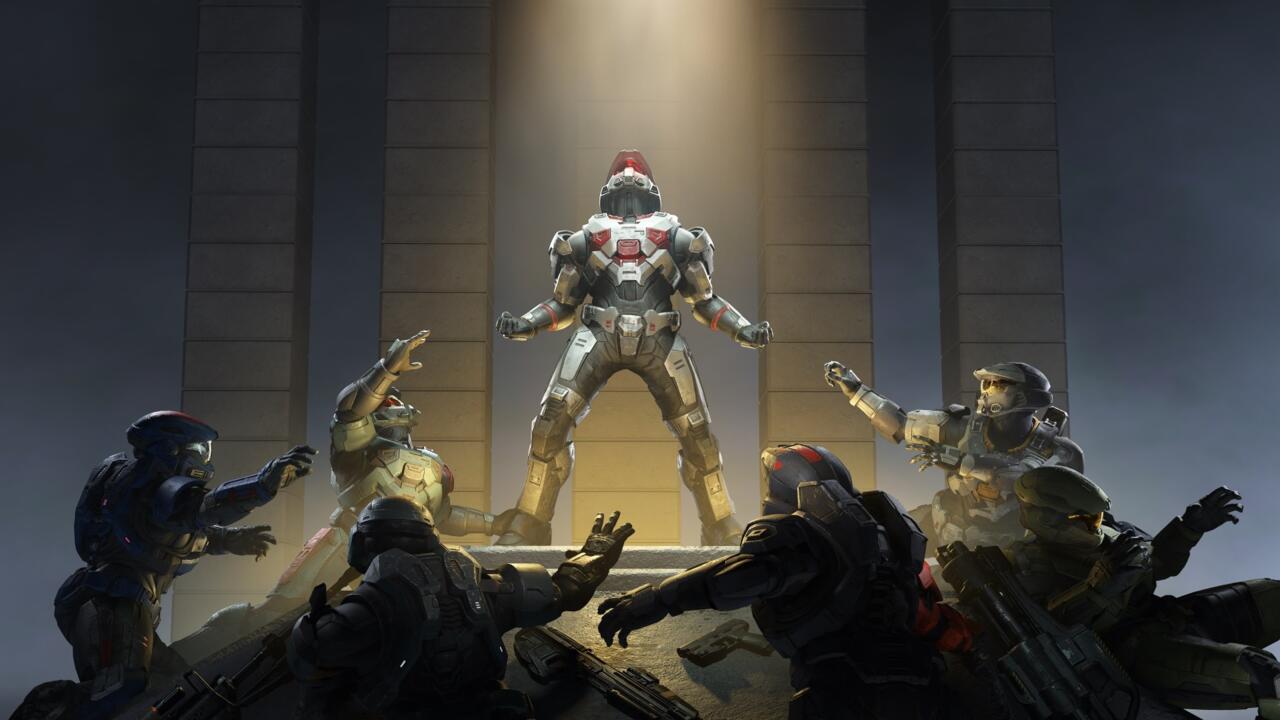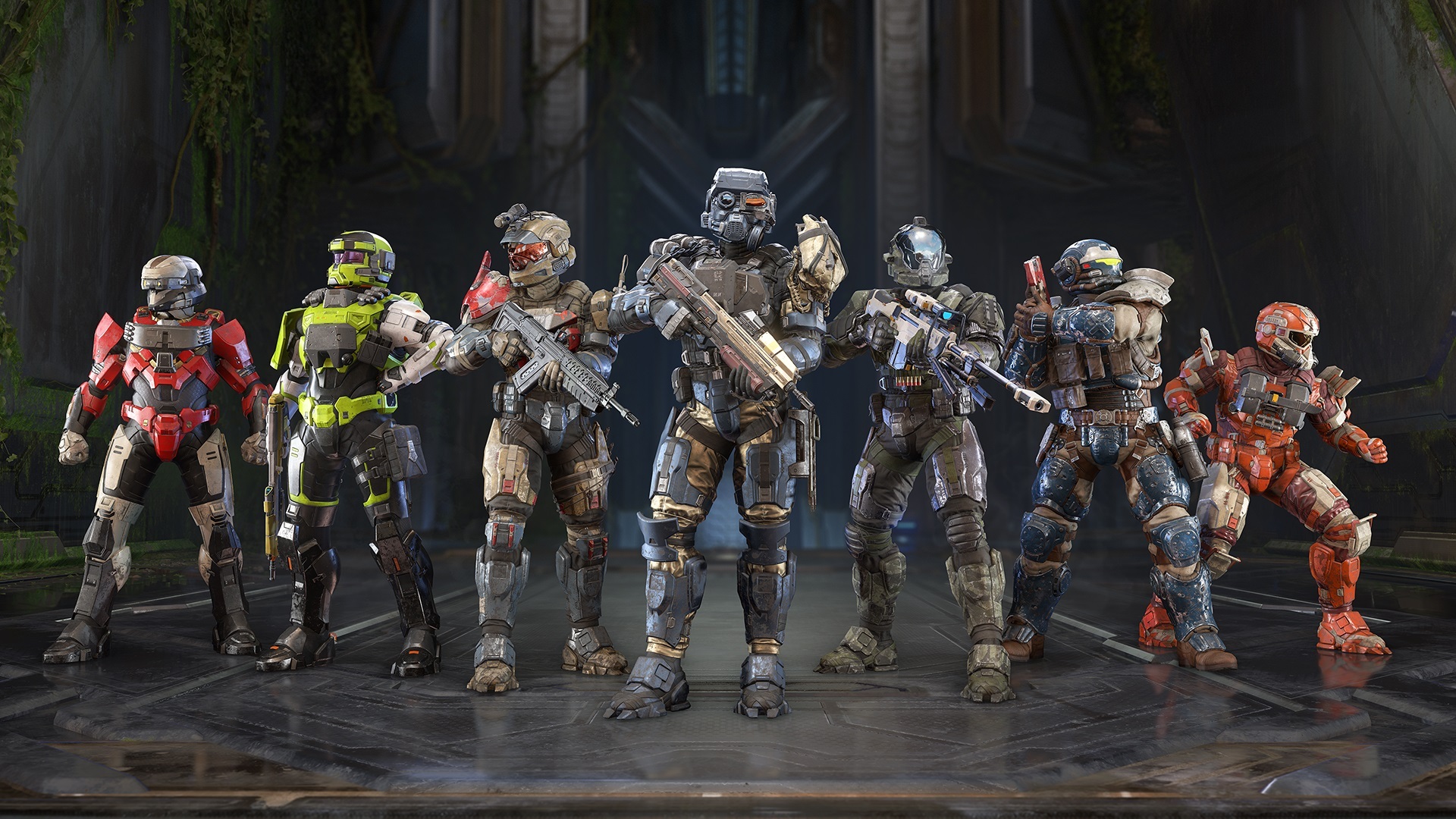I could spend all day talking about what makes Halo Infinite‘s multiplayer good but not necessarily great. When you’re in the thick of it, though, the faults creating that distinction are hard to notice because it’s just really fun. While playing, I regularly find myself giggling with murderous glee after successfully wiping an enemy team all on my own, or laughing as I nonchalantly chuck a fusion coil and accidentally splatter an unseen player. But the multiplayer just doesn’t provide enough incentive to make it a part of my daily rotation of free-to-play online shooters.
Developer 343 Industries has stuck the landing on what matters the most, however, as Halo Infinite feels good. Firearms shoot with a nice punch, and your Spartan’s movements are smooth. And although not every map feels like they’re going down in Halo’s hall of fame as all-time favorites, there’s a welcome variety to them, allowing the assortment of game types to play out in wildly different ways depending on which map you’re playing on.
Similar to Halo 4 and Halo 5: Guardians, the narrative basis for Halo Infinite’s multiplayer is a Spartan training program. With both Master Chief and the UNSC Infinity marked as missing in action, Spartan Commander Agryna leaves you behind at a secure facility that’s tasked with training the next generation of Spartan IVs. It’s up to you to work hard and grow stronger in preparation for the coming fight.

The multiplayer feels like old-school Halo, but tweaked to better fit the modern FPS playerbase who have fallen in love with shooters that accentuate their solid gunplay with smooth movement and quick-to-deploy abilities. Halo Infinite leans into the traditional rhythm of the series’ firefights–it’s a dance that is familiar to long-time fans but manages to feel wholly unique in today’s shooter climate given the longer time-to-kill rate in comparison to most other first-person shooters.
Though fights can be ended quickly with the right weapon (or just having vastly superior numbers), most don’t on account of each Spartan’s rechargeable shield, which divides combat into two distinct parts. While shielded, you can take more risks and utilize weapons that take longer to have an immediate payoff (like the Plasma Pistol, which can be charged to fire a more powerful shot), but when that shield is gone, you’re vulnerable, and the need to take more evasive maneuvers increases (or you can pull out a faster-hitting weapon, like the fully automatic MA40 Assault Rifle, to outpace your opponent’s shots). If you can last long enough, your shield will recharge, reverting you back to the first phase.
As all players are tied to these constraints, fights are typically less about what weapon you have and more about how you choose to use it. A charged Plasma Pistol shot will decimate an opponent’s shields faster than the MA40, but if a player with the MA40 can move side to side fast enough and avoid the loose lock-on of the Plasma Pistol, they can land enough hits to break that shield first, and the MA40 tears through unshielded targets significantly faster. Halo has consistently been a game of skill that rewards players for fighting intelligently and knowing how to best defeat an opponent, and Halo Infinite sticks to that trend.
Equipment complements the gunplay, with every piece being useful in some way, and most being useful in different ways from mode to mode. For example, Repulsor, which sends out a shockwave to knock back everything in front of you, is great for flinging vehicles off cliffs, but can just as easily save your life from a surprise grenade. Brief cooldowns, limited uses, and the need to collect them keeps each piece of equipment from being incessantly spammed, ensuring skilled use of firearms remains the key component to Halo’s in-match meta.
Halo Infinite’s movement mechanics pair well with the game’s firearms and equipment, encouraging fast and aggressive play. The ability to slide after sprinting is especially noteworthy, as you go just far enough and just fast enough to quickly turn tight corners for both offense or defense. It feels as essential to combat as strafing or jumping when it comes to avoiding shots, and correctly timing a jump to go into a lengthy slide to swing around a corner and surprise your opponent by shooting them from a lower angle than they were expecting is fulfilling.
Of the new-school shooter mechanics that make their way into Halo Infinite, the ping system is the only one to really fall short. Halo’s core formula wasn’t built with a ping system in mind, and Halo Infinite isn’t restructured to address that fact. The ping itself isn’t very informative–though it thankfully does tell squadmates how many enemies are at a location, it doesn’t provide context when pinging a place on the map. That can make it tricky to discern whether a teammate is saying to go to a spot, defend a spot, or attack a spot. Putting the ping on the D-pad on a controller also makes it hard to use the mechanic in the midst of a fight. Given how many objective-based modes are in Halo Infinite, a ping system is a smart idea for helping teams coordinate their efforts. However, the existing system isn’t helpful or easy to use, and since so few people use it, players aren’t conditioned to take heed of it and largely ignore it when their allies do happen to use it.

343 Industries has thankfully been expanding upon the limited number of playlists that Halo Infinite had at launch. The core four–Bot Bootcamp, Quick Play, Big Team Battle, and Ranked Arena–remain, providing a solid backbone for those just looking to play some Halo. Bot Bootcamp hosts an assortment of 4v4 modes but is set in a PvE setting, allowing new faces to test and improve their skills prior to diving into online matchmaking. Quick Play and Big Team Battle are Halo Infinite’s two general online multiplayer playlists for those wanting a healthy sample platter of choices in a casual setting–the first includes many of the game’s assortment of 4v4 game types, while the second focuses on 12v12. And finally, Ranked Arena presents competitive variations of what’s found in Bot Bootcamp and Quick Play, pushing you to go up against similarly skilled players in attempts to rise in rank.
Since its launch, Halo Infinite has gained several new playlists, offering a much-needed means for players looking to curate their time with the game towards modes they prefer. These playlists collect Halo Infinite’s 13 modes (several of which have multiple variations). It’s a good assortment, providing a healthy option for those who just want to shoot stuff or those who prefer a more objective-based offering where teams work together to complete a goal, not get the most kills. It still feels a bit lacking though, given the continued absence of Forge and fan-favorite modes like Infection and Warzone (Elimination is still absent, as well).
This greater variety of playlists and modes also serves another purpose: It makes leveling in the battle pass far easier. Given the hyperspecific nature of most of Halo Infinite’s challenges–oftentimes asking you to capture zones in specific modes or kill enemies with a particular weapon–having the agency to pick what you queue into can alleviate some of the frustrating grind.
That frustration is still there though, even two seasons into Halo Infinite’s multiplayer. 343 Industries did make adjustments to the game’s challenge-based progression system, but leveling in Halo Infinite can oftentimes still feel tedious. And that grind to level in the battle pass is ultimately unfulfilling given the rather boring assortment of unlockables available–the first battle pass includes multiple shades of blue and gray colorings for your Spartan, for example, lacking much in the way of excitement for most of the pass.
The challenge system also gets in the way of just having fun in Halo Infinite, as skillfully playing objectives and just being a good teammate aren’t typically rewarded through the progression system. Most challenges involve getting kills, which is a constant encouragement to go after and kill as many enemy players as you can in matches, regardless if that’s the actual goal or not–and in Halo Infinite, that’s not the case for half of the modes.
Plus, the challenges are oftentimes too specific. Many challenges require you to play certain modes or use a weapon that can only be found on specific maps, and it’s a nuisance to feel like you’re being encouraged away from playing what you want in order to complete challenges. Challenge Swaps do exist, affording you the option of switching an unwanted challenge for something you’d prefer to do instead, but they aren’t infinite. And since Halo Infinite’s challenge system primarily relies on a weekly rotation, there isn’t much incentive to come back to the game for a whole week if most of your weeklies are asking you to play modes you’d rather skip.

Given how long it takes Halo Infinite to get from season to season (both Seasons 1 and 2 are six months long, for instance), there’s also a severe lack of incentive to keep playing midway through. Even with how much of a grind it is to get through Halo Infinite’s battle passes, it doesn’t take six months’ worth of time to do it, potentially resulting in months at the tail end of a season where you’re not really earning anything if you’re a dedicated player. It’s such a strange and ultimately unrewarding sensation, where it feels like Halo Infinite wants me to play a lot in order to earn anything new but by doing so I ultimately end up with nothing to earn just over halfway through the season.
It certainly doesn’t help that post-launch support for Halo Infinite has been so slow. The game has only gotten a small assortment of new maps and no new weapons at all. It is an altogether solid library of maps–there are a few that make me groan in exasperation whenever they pop up (Highpower), but there’s a decent enough level of diversity to Halo Infinite’s arenas. Bazaar and Recharge are my two favorites, featuring prominent open middle spaces for those brave enough for a hectic shootout, while the outer rims of both maps encompass multiple levels of hallways and rooms for those looking for a longer but typically safer trip around the map. Fragmentation is also really fun–you can’t go wrong with a Halo map that’s two bases sitting across from one another in a long canyon.
Halo Infinite’s collection of firearms all obliterate, melt, zap, or crush enemies to death with a rewarding crunch. The core conceit remains unchanged: Alien weapons vaporize Spartan shields while human firearms tear through the unprotected fleshy bits. Halo Infinite does add a few totally new weapons, each designed with secondary effects or fire modes that, when strategically used, lead to satisfying results. For instance, the Shock Rifle can disintegrate a target with a headshot, but sending a beam into a Spartan’s chest can cause the electricity-based shots to arc to additional targets, damaging nearby enemies. The weapon’s shots can disrupt vehicles too, stalling Warthogs or causing Banshees to fall from the sky.
Fan favorites like the Energy Sword and M41 SPNKR return, rounding out a total roster of 20 firearms, two melee weapons, and four grenade types. The sound design for these weapons is superb–even if you can’t see an enemy, you can immediately identify what weapon they’re using based on the sound it’s making. The shots fired from each gun and the appearance of each grenade are also visually distinct (less so for the human weapons), which helps you identify what you’re up against in case a louder sound is masking the trademark noises of your foe’s weapon.
This all helps ensure the outcomes of firefights lean towards skill as opposed to luck. In the few seconds that a fight lasts, visual and auditory cues can tune you into what your foe is using against you, informing how you can respond to beat them. It wouldn’t be a Halo game without luck (or hilarious misfortune) also playing a part, and that’s present too. I’ve had a fight where I won, breathed a sigh of relief, and then a destroyed Wasp fell out of the sky and crushed me. These sorts of deaths of comedic misfortune aren’t what you’ll usually endure though, and for the most part, the better player (or just the player who better knew how to use the environment to turn the tables to their advantage) will come out on top.
Halo Infinite’s online multiplayer takes everything that is good about Halo and amplifies it with the faster pacing and abilities of more modern-day shooters. Not every new mechanic and feature fits Halo’s established formula–the ping system isn’t informative enough to work well, and tying all in-game progression to challenges leads to an unrewarding grind. I also wish there were a more regular cadence of updates to this live-service game, especially given the massive length of each season. But despite these issues, I keep coming back to the fact that Halo Infinite is just fun to play: This is a good free-to-play shooter, one where the sound design is spot on, the maps are good, weapons hit with gratifying kinetic energy, and the game rewards skill.

